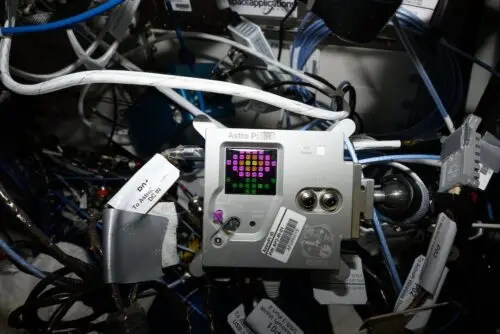Kategorie: PC
-

Linamp
Reading Time: 4 minutesFor his project, Rodrigo wanted to bring Winamp’s early days back to life in a more physical form so he decided to produce a music player that could easily be part of a hi-fi mini system. Specifically, he took inspiration from a Aiwa mini setup from around 1983, figuring he could create…
-

ArmPi FPV AI Vision review
Reading Time: 3 minutesStrong arm We tried out the Advanced kit with Raspberry Pi 5. The arm comes ready-assembled, sitting on a solid black metal base whose rear section holds Raspberry Pi, secured with screws and pillars. Four suction cups stick the base to a desk or the floor – not the most secure of…
-

Celebrating Astro Pi 2024
Reading Time: 5 minutesAbout the projects Over the past few months, young people across Europe have run their computer programs on the International Space Station (ISS) as part of Astro Pi Mission Zero and Mission Space Lab. Mission Zero code deployment | Credits: ESA/NASA Mission Zero offers young people the chance to write a simple…
-

Twirly Shirley
Reading Time: 3 minutesThat first turntable used a DC motor, which lacks precision, resulting in inconsistent movements which vary with the weight of the object placed on it. “We wanted something more precise,” recalls Martin, “and we wanted a remote that we didn’t keep losing, so we put it as a page on a web…
-

Essential electronics in The MagPi magazine issue #144
Reading Time: 2 minutesEssential Electronics. Become familiar with electronic components, circuit building, code and some great starter projects. This month’s lead feature will have you up and running with electronics and code in no time at all. Build a private cloud server Take control of your data by building a do-it-all email, documents, spreadsheets, email,…
-

Win one of three Home Assistant Yellows
Reading Time: < 1 minuteSave 35% off the cover price with a subscription to The MagPi magazine. UK subscribers get three issues for just £10 and a FREE Raspberry Pi Pico W, then pay £30 every six issues. You’ll save money and get a regular supply of in-depth reviews, features, guides and other Raspberry Pi…
-

New guide on using generative AI for teachers and schools
Reading Time: 5 minutesThe world of education is loud with discussions about the uses and risks of generative AI — tools for outputting human-seeming media content such as text, images, audio, and video. In answer, there’s a new practical guide on using generative AI aimed at Computing teachers (and others), written by a group of…
-

Four key learnings from teaching Experience AI lessons
Reading Time: 4 minutesDeveloped by us and Google DeepMind, Experience AI provides teachers with free resources to help them confidently deliver lessons that inspire and educate young people about artificial intelligence (AI) and the role it could play in their lives. Tracy Mayhead is a computer science teacher at Arthur Mellows Village College in Cambridgeshire.…
-

Empowering undergraduate computer science students to shape generative AI research
Reading Time: 6 minutesAs use of generative artificial intelligence (or generative AI) tools such as ChatGPT, GitHub Copilot, or Gemini becomes more widespread, educators are thinking carefully about the place of these tools in their classrooms. For undergraduate education, there are concerns about the role of generative AI tools in supporting teaching and assessment practices.…
-

Retro gaming magic mirror
Reading Time: 2 minutesWith that in mind, he went big. And we mean really big. He took a 65-inch touchscreen and connected it to a Raspberry Pi 5 computer, figuring games would look amazing across such a large display. It also enabled David to create a full-length mirror, despite it posing issues of its own.…
-

Puttr indoor putting practice green
Reading Time: 4 minutesLike many great ideas, Puttr came about because of some enforced downtime during lockdown. Entrepreneur and founder of several successful start-ups Matthew Allard had been on the golf team at university, and lockdown had him contemplating an at-home putting game that he and his son could both enjoy. Matthew had a personal…
-

CrowPi Compact Raspberry Pi Educational Kit review
Reading Time: 2 minutesBox of delights Elsewhere on the board you’ll find a USB-C power input, speakers, an LED display, GPIO pins, an RFID chip, plenty of sensors and switches and LEDs, and more besides. In the box there’s also a startling array of extra components, including a pair of SNES-like gamepads, a US-style power…
-

Celebrating the AI innovators of tomorrow
Reading Time: 4 minutesAs the Experience AI Challenge has closed for submissions, we would like to thank all the talented young people who participated and submitted their projects this year. The Challenge, created by us in collaboration with Google DeepMind, guides young people under the age of 18, and their mentors, through the process of…
-

Raspberry Pi goes public
Reading Time: 2 minutesEvolution “This is a watershed moment for Raspberry Pi,” Eben posted on Raspberry Pi dot com that morning. “And the start of a new phase in our evolution: access to the public market will enable us to build more of the products you love, faster. And the money raised by the Raspberry…
-

A vote of thanks to our Trustees
Reading Time: 5 minutesTuesday 11 June 2024 will be remembered as one of the most important days in the history of Raspberry Pi. At the London Stock Exchange on 11 June 2024. The successful introduction of the Raspberry Pi Foundation’s commercial subsidiary on the London Stock Exchange is a genuinely remarkable achievement. I want to…
-

The Dicemaster 2000
Reading Time: 4 minutesFrom the start, Chris had an idea of what he wanted from the device. “I knew what I wanted to achieve – for my friend to press buttons, for virtual dice to be rolled and the result to be announced,” he says. “From there it was just about figuring out which components…
-

Hello World #24 out now: Impact of tech
Reading Time: 3 minutesDo you remember a time before social media? Mobile phones? Email? We are surrounded by digital technology, and new applications impact our lives whether we engage with them or not. Issue 24 of Hello World, out today for free, gives you ideas for how to help your learners think openly and critically…
-

Coolest Projects 2024: 7197 young tech creators showcase their projects online
Reading Time: 5 minutesOur Coolest Projects 2024 online showcase has come to a close, with 7197 young people from 43 countries sharing the incredible things they have made with code. A huge congratulations to everyone who took part! Coolest Projects is our annual global celebration of young digital creators and the cool things they make…
-

Build a robot explorer in The MagPi magazine issue #143
Reading Time: 3 minutesRobot Explorers Turn Raspberry Pi into a rugged robot, equipped with wheels or legs, and you can explore the surface of a planet (or your backyard) and use sensors to analyse your environment. This month, we’ve got a guide to the best robotic parts, equipment, and sensors to use. Dicemaster 2000 We…
-

Win one of five Raspberry Pi AI kits
Reading Time: < 1 minuteSave 35% off the cover price with a subscription to The MagPi magazine. UK subscribers get three issues for just £10 and a FREE Raspberry Pi Pico W, then pay £30 every six issues. You’ll save money and get a regular supply of in-depth reviews, features, guides and other Raspberry Pi…





















